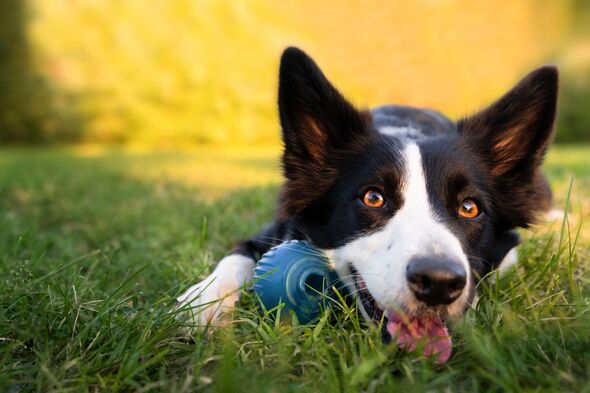Lifestyle
Enhance Your Pet’s Life with Simple Colour Choices and Adjustments

Understanding how pets perceive their environment can significantly enhance their quality of life. Recent research from Petplan, a UK-based pet insurance provider, highlights the importance of tailoring home settings and toys to better suit the visual and sensory experiences of dogs and cats. The findings urge pet owners to implement small but impactful changes to improve their pets’ wellbeing.
Key Insights into Pet Perception
The study conducted by Petplan involved collaboration with in-house specialists, including Dr. Brian Faulkner, a veterinarian and Associate Professor at Nottingham Veterinary School. He emphasizes the significance of recognizing how pets interpret their surroundings. “When we understand how our pets see the world, we can adapt how we interact with them,” says Dr. Faulkner. This includes choosing toys in specific colours that stand out and designing play spaces that stimulate their senses.
Dogs, for instance, have only two types of colour receptors compared to the three found in humans. As a result, they can primarily distinguish between shades of yellow and blue. They often experience red-green colour blindness, which can make these colours appear as varying shades of brown and gray. “Knowing this can really help owners make smarter choices,” Dr. Faulkner adds, indicating that selecting brightly coloured toys can assist dogs in spotting them more efficiently.
Cats, on the other hand, have unique visual capabilities. They cannot see in total darkness but possess larger corneas, providing night vision that is approximately eight times better than humans. While their ability to perceive greens and reds is limited, they can detect fast-moving objects more vividly. Nicky Trevorrow, Behaviour Manager at Cats Protection, notes that understanding a cat’s vision can clarify their behaviour, such as their intense gazes or sudden pounces.
Practical Steps to Enhance Pet Environments
Owners can take several practical steps to create a more stimulating and comfortable environment for their pets. Here are some recommendations based on the research:
1. **Choose toys in yellow and blue**: These colours are more visible to pets. For example, opting for a yellow mouse or a blue bone can enhance playtime engagement.
2. **Introduce varied textures**: Incorporating different materials, such as soft blankets and scratching posts, provides comfort and sensory stimulation. A textured rug can aid pets in navigating spaces more effectively.
3. **Stimulate their sense of smell**: Dogs have an exceptional sense of smell, capable of detecting scents from up to 12 miles away. Popular scents for dogs include lavender, mint, and blackberries. Cats, too, have preferences for herbal scents like catnip and valerian.
4. **Bring the outdoors in**: Allowing fresh air to flow by slightly opening windows can introduce outdoor scents that pets find appealing.
5. **Lower the lighting**: Since pets generally see better in lower light conditions, dimming indoor lights can create a calming atmosphere for them.
By implementing these small adjustments, pet owners can significantly enhance their animals’ quality of life. Dr. Faulkner concludes, “These small details can make a big difference to your pet’s wellbeing.” Understanding and catering to the unique sensory experiences of dogs and cats fosters a more harmonious living environment for both pets and their owners.
-

 Entertainment1 month ago
Entertainment1 month agoAnn Ming Reflects on ITV’s ‘I Fought the Law’ Drama
-

 Entertainment2 months ago
Entertainment2 months agoKate Garraway Sells £2 Million Home Amid Financial Struggles
-

 Health1 month ago
Health1 month agoKatie Price Faces New Health Concerns After Cancer Symptoms Resurface
-

 Entertainment2 months ago
Entertainment2 months agoKim Cattrall Posts Cryptic Message After HBO’s Sequel Cancellation
-

 Entertainment1 month ago
Entertainment1 month agoWhere is Tinder Swindler Simon Leviev? Latest Updates Revealed
-

 Entertainment2 months ago
Entertainment2 months agoMasterChef Faces Turmoil as Tom Kerridge Withdraws from Hosting Role
-

 Entertainment3 months ago
Entertainment3 months agoSpeculation Surrounds Home and Away as Cast Departures Mount
-

 World1 month ago
World1 month agoCole Palmer’s Mysterious Message to Kobbie Mainoo Sparks Speculation
-

 Entertainment1 month ago
Entertainment1 month agoITV’s I Fought the Law: Unraveling the True Story Behind the Drama
-

 Entertainment3 weeks ago
Entertainment3 weeks agoCaz Crowned Winner of The Great British Sewing Bee, Overjoyed by Triumph
-

 Entertainment2 months ago
Entertainment2 months agoAldi Launches Cozy Autumn Fragrance Range Ahead of Halloween
-

 Entertainment2 months ago
Entertainment2 months agoMarkiplier Addresses AI Controversy During Livestream Response




















